ignition JAGUAR XJ6 1994 2.G Repair Manual
[x] Cancel search | Manufacturer: JAGUAR, Model Year: 1994, Model line: XJ6, Model: JAGUAR XJ6 1994 2.GPages: 521, PDF Size: 17.35 MB
Page 481 of 521
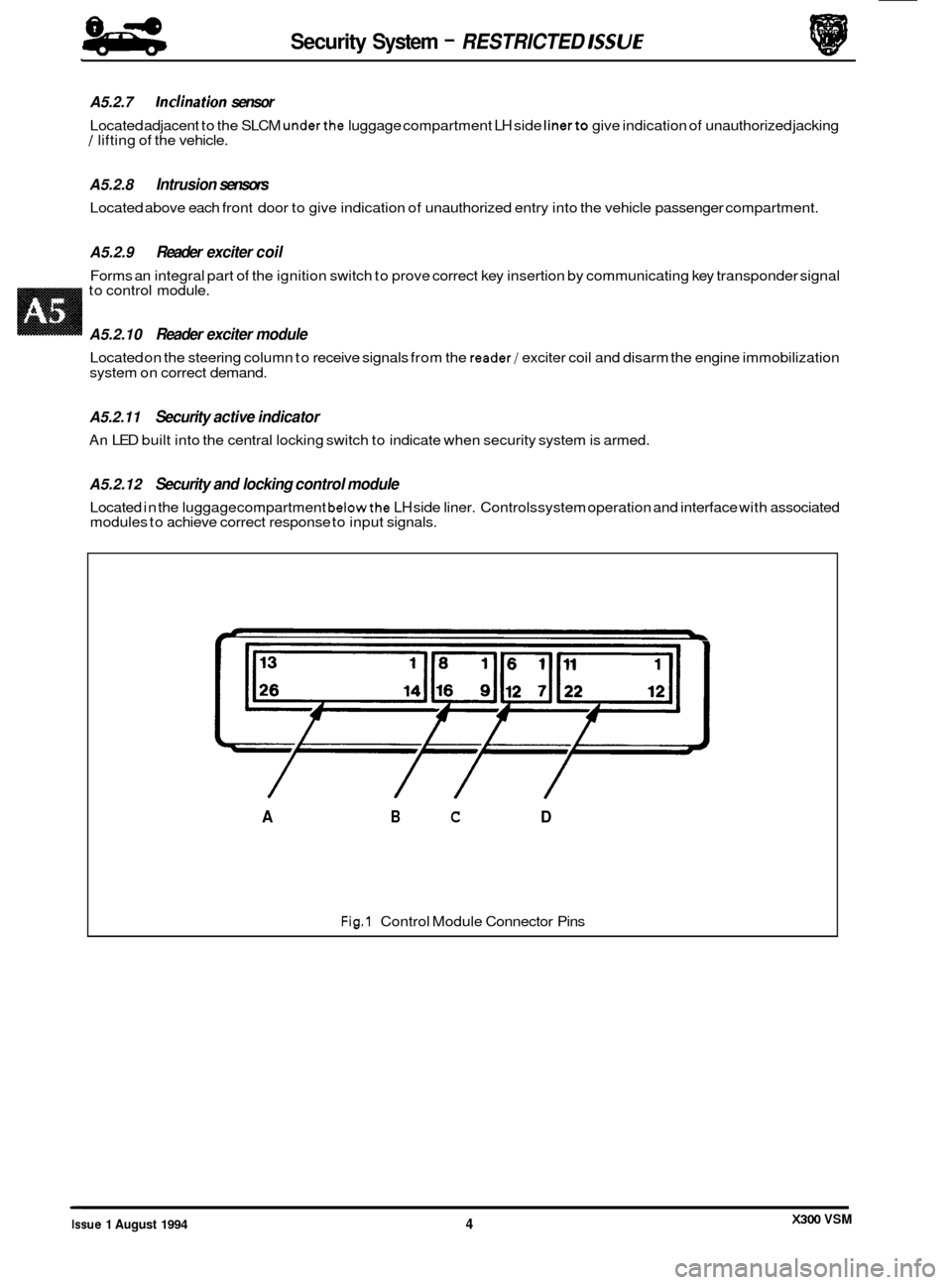
84
- Security System - RESTRICTED /SSU€
A5.2.7 Inclination sensor
Located adjacent to the SLCM underthe luggage compartment LH side linerto give indication of unauthorized jacking / lifting of the vehicle.
A5.2.8 Intrusion sensors
Located above each front door to give indication of unauthorized entry into the vehicle passenger compartment.
A5.2.9 Reader exciter coil
Forms an integral part of the ignition switch to prove correct key insertion by communicating key transponder signal
to control module.
A5.2.10 Reader exciter module
Located on the steering column to receive signals from the reader/ exciter coil and disarm the engine immobilization
system on correct demand.
A5.2.11 Security active indicator
An LED built into the central locking switch to indicate when security system is armed.
A5.2.12 Security and locking control module
Located in the luggage compartment belowthe LH side liner. Controls system operation and interface with associated
modules to achieve correct response to input signals.
L
Fig.1 Control Module Connector Pins
/ // /
A B C D
X300 VSM Issue 1 August 1994 4
Page 484 of 521
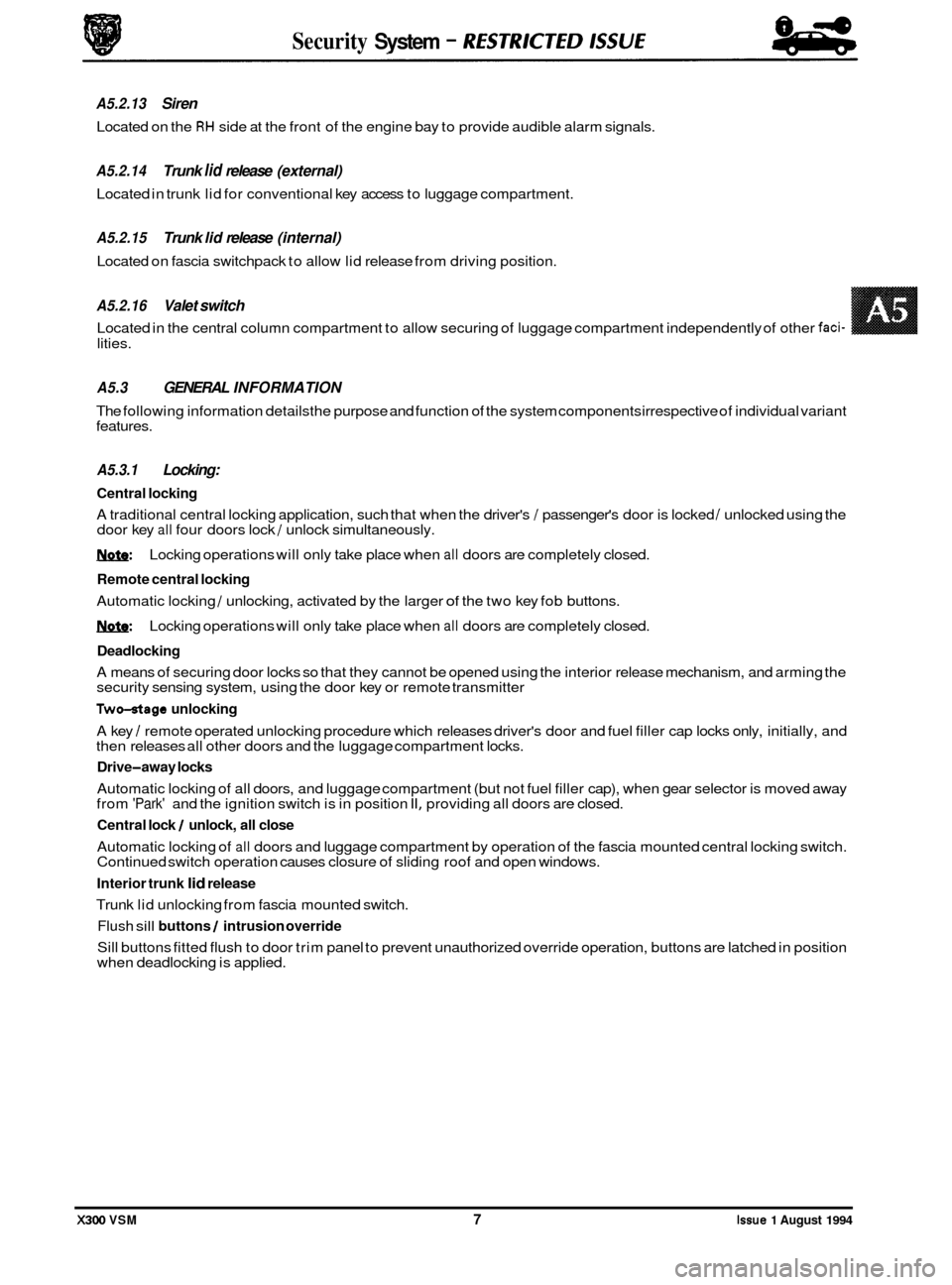
lities.
A5.3 GENERAL INFORMATION
The following information detailsthe purpose and function of the system components irrespective of individual variant
features.
A5.3.1 Locking:
Central locking
A traditional central locking application, such that when the driver's / passenger's door is locked / unlocked using the
door key all four doors lock / unlock simultaneously.
1ynfe: Locking operations will only take place when all doors are completely closed.
Remote central locking
Automatic locking / unlocking, activated by the larger of the two key fob buttons.
1ynfe: Locking operations will only take place when all doors are completely closed.
Deadlocking
A means of securing door locks so that they cannot be opened using the interior release mechanism, and arming the
security sensing system, using the door key or remote transmitter
Two-otage unlocking
A key / remote operated unlocking procedure which releases driver's door and fuel filler cap locks only, initially, and
then releases all other doors and the luggage compartment locks.
Drive-away locks
Automatic locking of all doors, and luggage compartment (but not fuel filler cap), when gear selector is moved away
from 'Park' and the ignition switch is in position II, providing all doors are closed.
Central lock / unlock, all close
Automatic locking of all doors and luggage compartment by operation of the fascia mounted central locking switch.
Continued switch operation causes closure of sliding roof and open windows.
Interior trunk lid release
Trunk lid unlocking from fascia mounted switch.
Flush sill buttons / intrusion override
Sill buttons fitted flush to door trim panel to prevent unauthorized override operation, buttons are latched in position
when deadlocking is applied.
Security System - RESTRKTED lSSUE
A5.2.13 Siren
Located on the RH side at the front of the engine bay to provide audible alarm signals.
A5.2.14 Trunk lid release (external)
Located in trunk lid for conventional key access to luggage compartment.
A5.2.15 Trunk lid release (internal)
Located on fascia switchpack to allow lid release from driving position.
A5.2.16 Valet switch
Located in the central column compartment to allow securing of luggage compartment independently of other faci-
X300 VSM 7 Issue 1 August 1994
Page 485 of 521
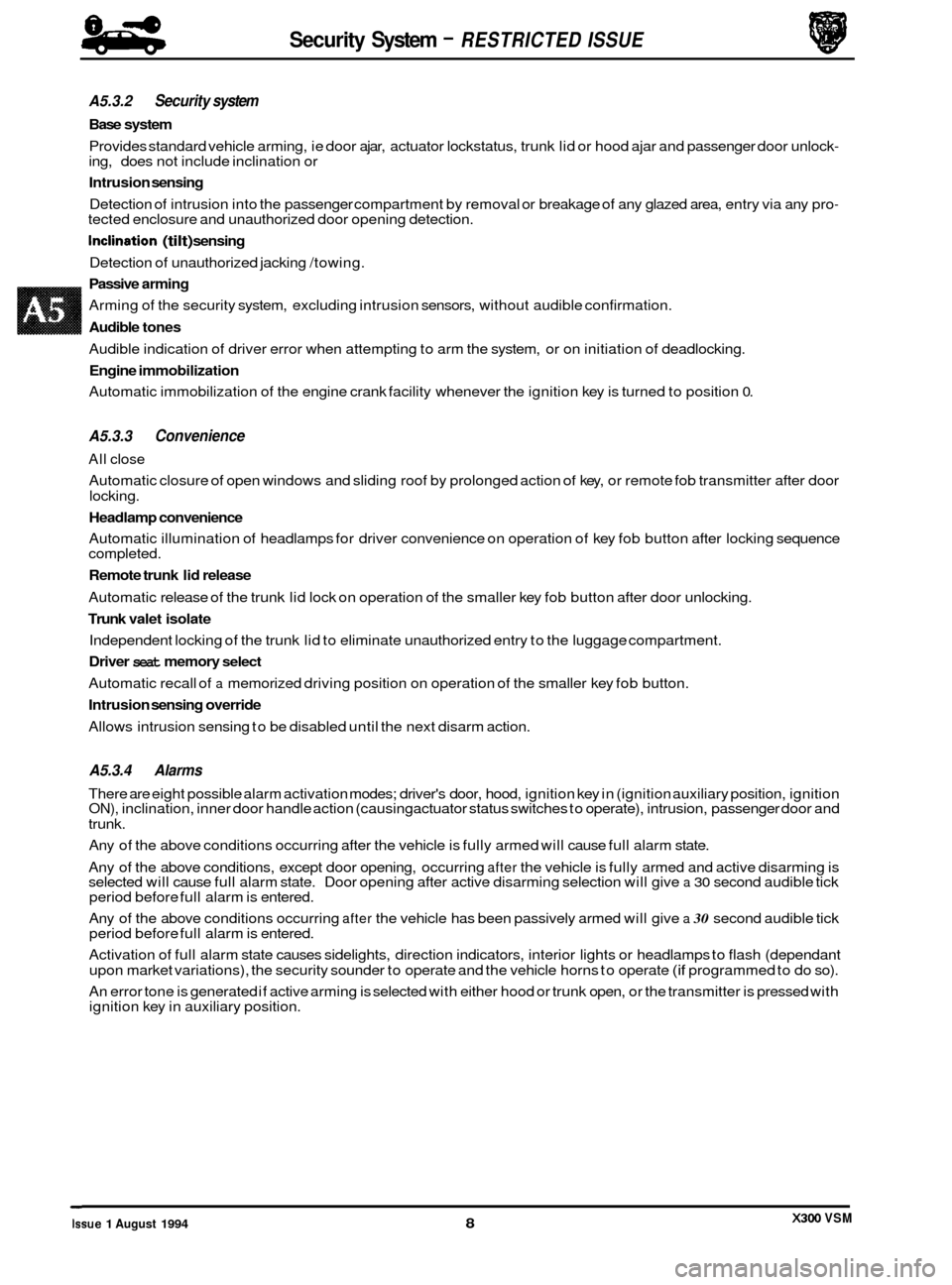
Security System - RESTRICTED ISSUE 8-8
-
A5.3.2 Security system
Base system
Provides standard vehicle arming, ie door ajar, actuator lockstatus, trunk lid or hood ajar and passenger door unlock- ing, does not include inclination or
Intrusion sensing
Detection of intrusion into the passenger compartment by removal or breakage of any glazed area, entry via any pro- tected enclosure and unauthorized door opening detection.
Inclination (tilt) sensing
Detection of unauthorized jacking /towing.
Passive arming
Arming of the security system, excluding intrusion sensors, without audible confirmation.
Audible tones
Audible indication of driver error when attempting to arm the system, or on initiation of deadlocking.
Engine immobilization
Automatic immobilization of the engine crank facility whenever the ignition key is turned to position 0.
A5.3.3 Convenience
All close
Automatic closure of open windows and sliding roof by prolonged action of key, or remote fob transmitter after door
locking.
Headlamp convenience
Automatic illumination of headlamps for driver convenience on operation of key fob button after locking sequence
completed.
Remote trunk lid release
Automatic release of the trunk lid lock on operation of the smaller key fob button after door unlocking.
Trunk valet isolate
Independent locking of the trunk lid to eliminate unauthorized entry to the luggage compartment.
Driver seat memory select
Automatic recall of a memorized driving position on operation of the smaller key fob button.
Intrusion sensing override
Allows intrusion sensing to be disabled until the next disarm action.
A5.3.4 Alarms
There are eight possible alarm activation modes; driver's door, hood, ignition key in (ignition auxiliary position, ignition ON), inclination, inner door handle action (causing actuator status switches to operate), intrusion, passenger door and
trunk.
Any of the above conditions occurring after the vehicle is fully armed will cause full alarm state.
Any of the above conditions, except door opening, occurring
after the vehicle is fully armed and active disarming is
selected will cause full alarm state. Door opening after active disarming selection will give a 30 second audible tick
period before full alarm is entered.
Any of the above conditions occurring
after the vehicle has been passively armed will give a 30 second audible tick
period before full alarm is entered.
Activation of full alarm state causes sidelights, direction indicators, interior lights or headlamps to flash (dependant
upon market variations), the security sounder to operate and the vehicle horns to operate
(if programmed to do so).
An error tone is generated if active arming is selected with either hood or trunk open, or the transmitter is pressed with
ignition key in auxiliary position.
0
X300 VSM Issue 1 August 1994 8
Page 489 of 521
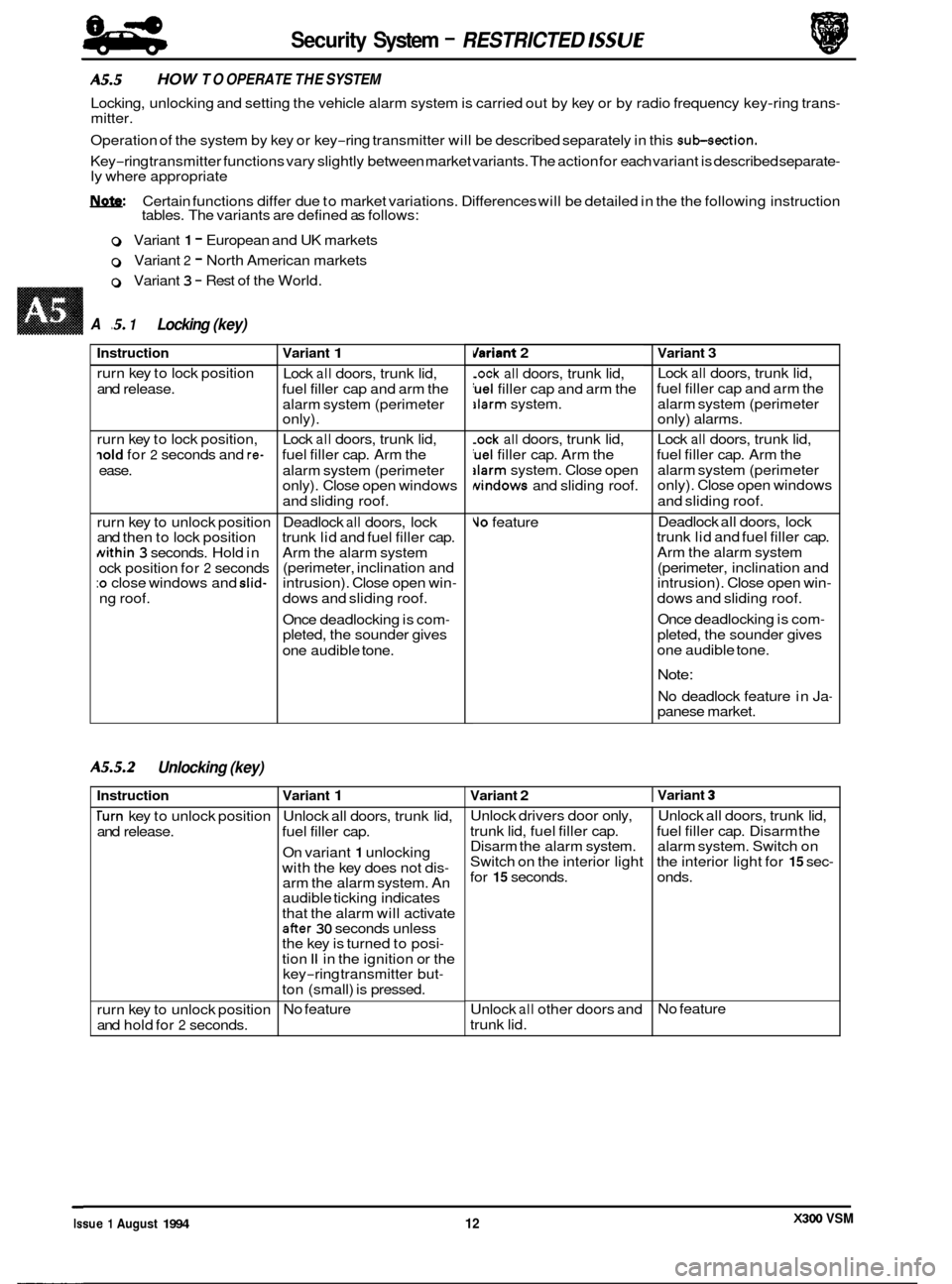
Security System - RESTRICTED /SSUE 84
-
Uo feature
A5.5 HOW TO OPERATE THE SYSTEM
Deadlock all doors, lock
trunk lid and fuel filler cap.
Arm the alarm system
(perimeter, inclination and
intrusion). Close open win
-
dows and sliding roof.
Once deadlocking is com
-
pleted, the sounder gives
one audible tone.
Note:
No deadlock feature in Ja- panese market.
Locking, unlocking and setting the vehicle alarm system is carried out by key or by radio frequency key-ring trans- mitter.
Unlock
all other doors and
trunk lid.
- Operation of the system by key or key-ring transmitter will be described separately in this sub-section.
Key-ring transmitter functions vary slightly between market variants. The action for each variant is described separate- ly where appropriate
m: Certain functions differ due to market variations. Differences will be detailed in the the following instruction
tables. The variants are defined as follows:
No feature
A
0 Variant 1 - European and UK markets
0 Variant 2 - North American markets
0 Variant 3 - Rest of the World.
,5. 1 Locking (key)
Instruction
rurn key to lock position
and release.
rurn key to lock position,
?old for 2 seconds and re-
ease.
rurn key to unlock position
and then to lock position
Nithin 3 seconds. Hold in
ock position for
2 seconds :o close windows and slid-
ng roof.
A5.5.2 Unlocking (key)
Instruction
Turn key to unlock position
and release.
rurn key to unlock position
and hold for
2 seconds.
Variant 1
Lock all doors, trunk lid,
fuel filler cap and arm the
alarm system (perimeter
only).
Lock
all doors, trunk lid,
fuel filler cap. Arm the
alarm system (perimeter
only). Close open windows
and sliding roof.
Deadlock
all doors, lock
trunk lid and fuel filler cap.
Arm the alarm system
(perimeter, inclination and
intrusion). Close open win
-
dows and sliding roof.
Once deadlocking is com
- pleted, the sounder gives
one audible tone.
Variant 1
Unlock all doors, trunk lid,
fuel filler cap.
On variant
1 unlocking
with the key does not dis
- arm the alarm system. An
audible ticking indicates
that the alarm will activate
after 30 seconds unless
the key is turned to posi-
tion II in the ignition or the
key-ring transmitter but-
ton (small) is pressed.
No feature
rlariant 2
-ock all doors, trunk lid,
'uel filler cap and arm the alarm system.
Variant 3
Lock all doors, trunk lid,
fuel filler cap and arm the
alarm system (perimeter
only) alarms.
-ock all doors, trunk lid,
'uel filler cap. Arm the
alarm system. Close open
Nindows and sliding roof. Lock
all doors,
trunk lid,
fuel filler cap. Arm the
alarm system (perimeter
only). Close open windows
and sliding roof.
Variant 2 I Variant 3
Unlock drivers door only,
trunk lid, fuel filler cap.
Disarm the alarm system.
Switch on the interior light
for
15 seconds. Unlock
all doors, trunk lid,
fuel filler cap. Disarm the
alarm system. Switch on
the interior light for
15 sec-
onds.
X300 VSM Issue 1 August 1994 12
Page 490 of 521
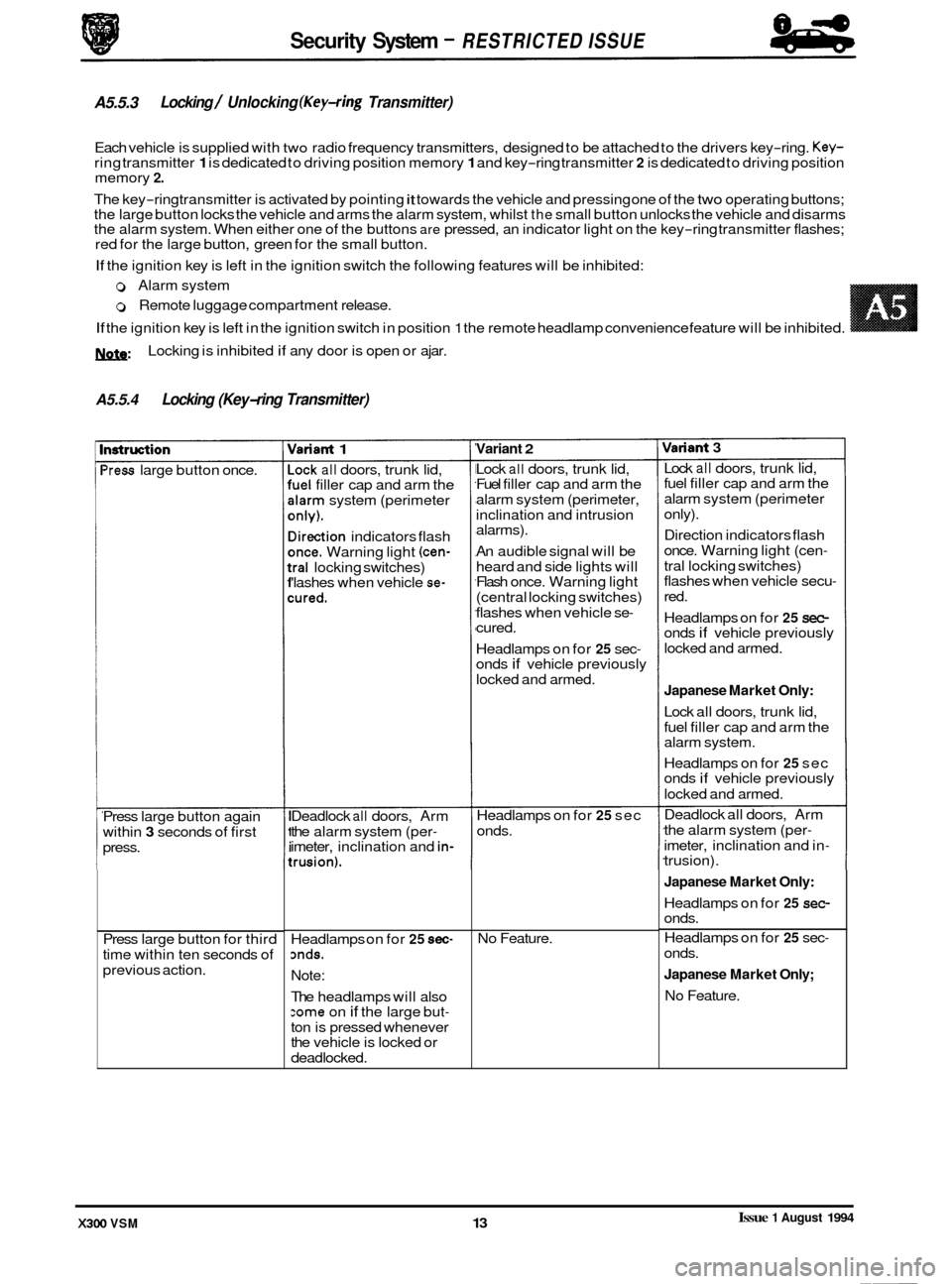
w:
A5.5.4 Locking (Key-ring Transmitter)
Locking is inhibited if any door is open or ajar.
nstruction
'ress large button once.
Press large button again
within
3 seconds of first
press.
Press large button for third
time within ten seconds of
previous action.
rlariant 1
-ock all doors, trunk lid, 'uel filler cap and arm the
darm system (perimeter
mly).
lirection indicators flash
mce. Warning light (cen-
:ral locking switches)
'lashes when vehicle se-
:ured.
Deadlock all doors, Arm
the alarm system (per
- imeter, inclination and in-
:rusion).
Variant 2
Security System - RESTRICTED ISSUE
A5.5.3
Each vehicle is supplied with two radio frequency transmitters, designed to be attached to the drivers key-ring. Key- ring transmitter 1 is dedicated to driving position memory 1 and key-ring transmitter 2 is dedicated to driving position
memory 2.
The key-ring transmitter is activated by pointing it towards the vehicle and pressing one of the two operating buttons;
the large button locks the vehicle and arms the alarm system, whilst the small button unlocks the vehicle and disarms
the alarm system. When either one of the buttons are pressed, an indicator light on the key-ring transmitter flashes;
red for the large button, green for the small button.
If the ignition key is left in the ignition switch the following features will be inhibited:
Locking / Unlocking (Key-ring Transmitter)
0 Alarm system
0 Remote luggage compartment release.
If the ignition key is left in the ignition switch in position 1 the remote headlamp convenience feature will be inhibited. ~~ ~
Headlamps on for 25 sec- mds.
Note:
The headlamps will also :ome on if the large but-
ton is pressed whenever
the vehicle is locked or
deadlocked. Lock
all doors,
trunk lid,
Fuel filler cap and arm the
alarm system (perimeter,
inclination and intrusion
alarms).
An audible signal will be
heard and side lights will
Flash once. Warning light
(central locking switches)
flashes when vehicle se
- cured.
Headlamps on for
25 sec- onds if vehicle previously
locked and armed.
Headlamps on for
25 sec
onds.
No Feature.
Variant 3
Lock all doors, trunk lid,
fuel filler cap and arm the
alarm system (perimeter
only).
Direction indicators flash
once. Warning light (cen
-
tral locking switches)
flashes when vehicle secu-
red.
Headlamps on for
25 sec- onds if vehicle previously
locked and armed.
Japanese Market Only:
Lock all doors, trunk lid,
fuel filler cap and arm the
alarm system.
Headlamps on for
25 sec
onds if vehicle previously
locked and armed.
Deadlock all doors, Arm
the alarm system (per
-
imeter, inclination and in- trusion).
Japanese Market Only:
Headlamps on for 25 sec- onds.
Headlamps on for
25 sec-
onds.
Japanese Market Only;
No Feature.
Issue 1 August 1994 X300 VSM 13
Page 491 of 521
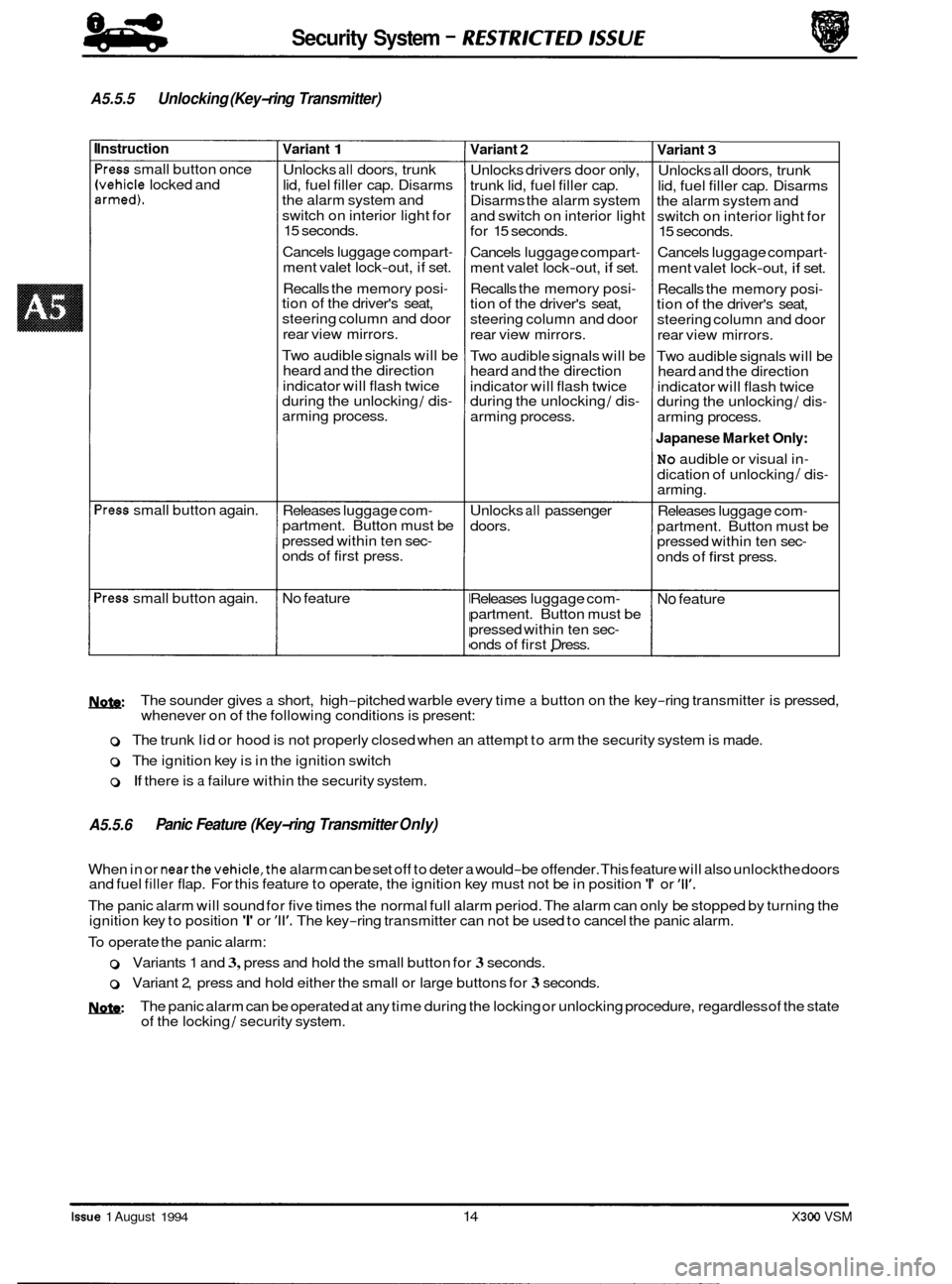
Security System - RESTRlCTED /SUE 84
-
A5.5.5 Unlocking (Key-ring Transmitter)
Instruction
'ress small button once
Ivehicle locked and armed).
'ress small button again.
>ress small button again.
Variant 1
Unlocks all doors, trunk
lid, fuel filler cap. Disarms
the alarm system and
switch on interior light for
15 seconds.
Cancels luggage compart
-
ment valet lock-out, if set.
Recalls the memory posi
- tion of the driver's seat,
steering column and door
rear view mirrors.
Two audible signals will be
heard and the direction
indicator will flash twice
during the unlocking
/ dis- arming process.
Releases luggage com
- partment. Button must be
pressed within ten sec
- onds of first press.
No feature
Variant 2
Unlocks drivers door only,
trunk lid, fuel filler cap.
Disarms the alarm system
and switch on interior light
for 15 seconds.
Cancels luggage compart
-
ment valet lock-out, if set.
Recalls the memory posi
- tion of the driver's seat,
steering column and door
rear view mirrors.
Two audible signals will be
heard and the direction
indicator will flash twice
during the unlocking
/ dis-
arming process.
Unlocks
all passenger
doors.
Releases luggage com
-
partment. Button must be
pressed within ten sec
- onds of first Dress.
Variant 3
Unlocks all doors, trunk
lid, fuel filler cap. Disarms
the alarm system and
switch on interior light for
15 seconds.
Cancels luggage compart
-
ment valet lock-out, if set.
Recalls the memory posi
- tion of the driver's seat,
steering column and door
rear view mirrors.
Two audible signals will be
heard and the direction
indicator will flash twice
during the unlocking
/ dis-
arming process.
Japanese Market Only:
No audible or visual in-
dication of unlocking / dis- arming.
Releases luggage com
-
partment. Button must be
pressed within ten sec-
onds of first press.
No feature
M&:
o The trunk lid or hood is not properly closed when an attempt to arm the security system is made.
0 The ignition key is in the ignition switch
0 If there is a failure within the security system.
The
sounder gives
a short, high-pitched warble every time a button on the key-ring transmitter is pressed,
whenever on of the following conditions is present:
A5.5.6 Panic Feature (Key-ring Transmitter Only)
When in or nearthe vehicle,the alarm can be set off to deter a would-be offender. This feature will also unlockthe doors
and fuel filler flap. For this feature to operate, the ignition key must not be in position 'I' or '11'.
The panic alarm will sound for five times the normal full alarm period. The alarm can only be stopped by turning the
ignition key to position 'I' or '11'. The key-ring transmitter can not be used to cancel the panic alarm.
To operate the panic alarm:
0 Variants 1 and 3, press and hold the small button for 3 seconds.
o Variant 2, press and hold either the small or large buttons for 3 seconds.
MzW The panic alarm can be operated at any time during the locking or unlocking procedure, regardless of the state
of the locking / security system.
Issue 1 August 1994 14 X300 VSM
Page 494 of 521

0 Variant 3 -Rest of the World.
A5.7.1 Locking (key)
Turn key to unlock position
and hold for 2 seconds.
nstruction I Variant 1 I Variant 2 I Variant 3
with the key does not dis-
arm the alarm system. An
audible ticking indicates
that the alarm will activate
after
30 seconds unless
the key is turned to posi
- tion II in the ignition or the
key
-ring transmitter but- ton (small) is pressed.
No feature
I I I rurn key to lock position
and release. imeter
onlv).arms.
Check that all doors, trunk lid and fuel filler cap lock and that the alarm system (per-
rurn key to lock position,
Told for 2 seconds and re-
Check that all doors, trunk lid and fuel filler cap lock,.the alarm system (perimeter
only) arms and all open windows and sliding roof close within 1.5 seconds.
ease.
rurn key to unlock position
and then to lock position
tvithin 3 seconds. Hold in
ock position for
2 seconds
:o close windows and slid- ng roof. Check
all doors
are dead-
locked and trunk lid and
fuel filler cap are locked.
Check alarm system (per
-
imeter, inclination and in- trusion) arms and all open
windows and sliding roof
close within 1.5 seconds.
Ensure that once deadlock
- ing is completed, the
sounder gives one audible
tone.
A5.7 SYSTEM TESTING
The following information details the procedures for a complete system test to identify and locate possible fault condi-
tions. Where faulty operation is identified refer to Diagnostic Sub-Routines for possible causes and remedies.
Locking, unlocking and setting the vehicle alarm system is carried out by key
or by radio frequency key-ring trans- mitter.
W:
Key-ring transmitter functions vary slightly between market variants. The action for each variant is described separate- ly where appropriate
m: Certain functions differ due to market variations. Differences will be detailed in the the following instruction
tables. The variants are defined as follows:
o Variant 1 - European and UK markets.
0 Variant 2 - North American markets.
Ensure
all doors
are fully closed before initiating lock procedures.
A5.7.2 Unlocking (key)
e Instruction Variant 1
Turn key to unlock position Check all doors, trunk lid
and release. and fuel filler cap unlock.
No feature
Variant 2
Check drivers door and
fuel filler cap unlock.
Check that the alarm
sys- tem disarms and the in-
terior light illuminates for
15 seconds.
Check all passenger doors
and trunk lid lock. Check
all doors
are dead-
locked and trunk lid and
fuel filler cap are locked.
Check alarm system (per
-
imeter, inclination and in- trusion) arms and all open
windows and sliding roof
close within 1.5 seconds.
Ensure that once deadlock
-
ing is completed, the
sounder gives one audible
tone.
Note:
No deadlock feature in Ja- panese market.
variant 3
Check all doors, trunk lid
and fuel filler cap. Check
that the alarm system dis
- arms and the interior light
illuminates for 15 seconds.
No feature
_____ X300 VSM 17 Issue 1 August 1994
Page 495 of 521
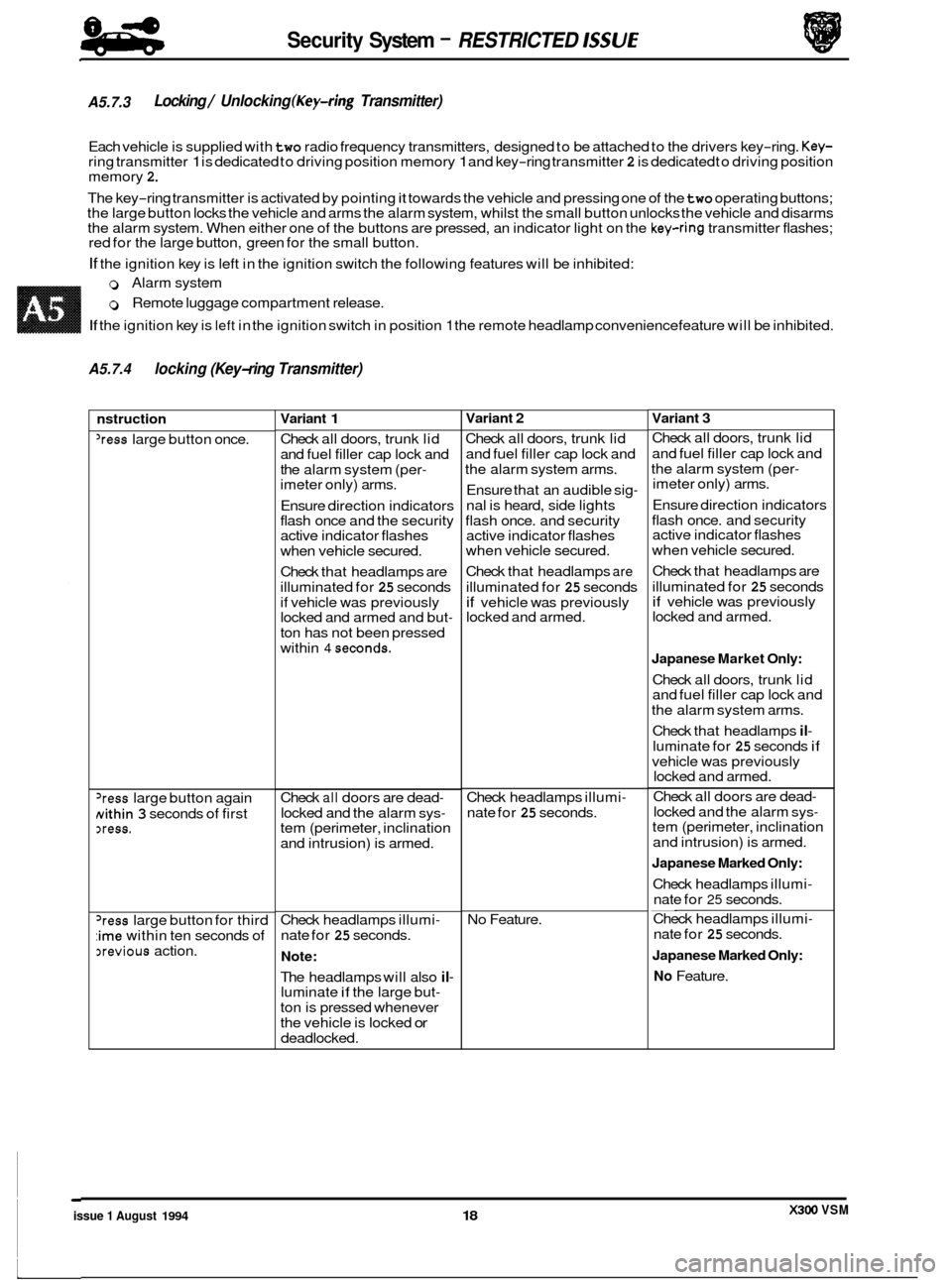
Security System - RESTRICTED MU€ 84
-
A5.7.3 Locking / Unlocking (Key-ring Transmitter)
Each vehicle is supplied with two radio frequency transmitters, designed to be attached to the drivers key-ring. Key- ring transmitter 1 is dedicated to driving position memory 1 and key-ring transmitter 2 is dedicated to driving position
memory 2.
The key-ring transmitter is activated by pointing it towards the vehicle and pressing one of the two operating buttons;
the large button locks the vehicle and arms the alarm system, whilst the small button unlocks the vehicle and disarms
the alarm system. When either one of the buttons are pressed, an indicator light on the
key-ring transmitter flashes;
red for the large button, green for the small button.
If the ignition key is left in the ignition switch the following features will be inhibited:
0 Alarm system
0 Remote luggage compartment release.
If the ignition key is left in the ignition switch in position 1 the remote headlamp convenience feature will be inhibited.
A5.7.4 locking (Key-ring Transmitter)
nstruction
'ress large button once.
'ress large button again
Nithin 3 seconds of first xess.
'ress large button for third
:ime within ten seconds of
3revious action.
Variant 1
Check all doors, trunk lid
and fuel filler cap lock and
the alarm system (per
- imeter only) arms.
Ensure direction indicators
flash once and the security
active indicator flashes
when vehicle secured.
Check that headlamps are
illuminated for
25 seconds
if vehicle was previously
locked and armed and but
-
ton has not been pressed
within
4 seconds.
Check all doors are dead-
locked and the alarm sys- tem (perimeter, inclination
and intrusion) is armed.
Check headlamps illumi
-
nate for 25 seconds.
Note:
The headlamps will also il- luminate if the large but-
ton is pressed whenever
the vehicle is locked
or
deadlocked.
Variant 2
Check all doors, trunk lid
and fuel filler cap lock and
the alarm system arms.
Ensure that an audible sig
-
nal is heard, side lights
flash once. and security
active indicator flashes
when vehicle secured.
Check that headlamps
are
illuminated for 25 seconds
if vehicle was previously
locked and armed.
Check headlamps illumi
-
nate for 25 seconds.
No Feature.
Variant 3
Check all doors, trunk lid
and fuel filler cap lock and
the alarm system (per
- imeter only) arms.
Ensure direction indicators
flash once. and security
active indicator flashes
when vehicle secured.
Check that headlamps are
illuminated for
25 seconds if vehicle was previously
locked and armed.
Japanese Market Only:
Check all doors, trunk lid
and fuel filler cap lock and
the alarm system arms.
Check that headlamps
il-
luminate for 25 seconds if
vehicle was previously
locked and armed.
Check all doors are dead
-
locked and the alarm sys- tem (perimeter, inclination
and intrusion) is armed.
Japanese Marked Only:
Check headlamps illumi-
nate for 25 seconds. __ Check headlamps illumi-
nate for 25 seconds.
Japanese Marked Only:
No Feature.
X300 VSM issue 1 August 1994 18
Page 497 of 521
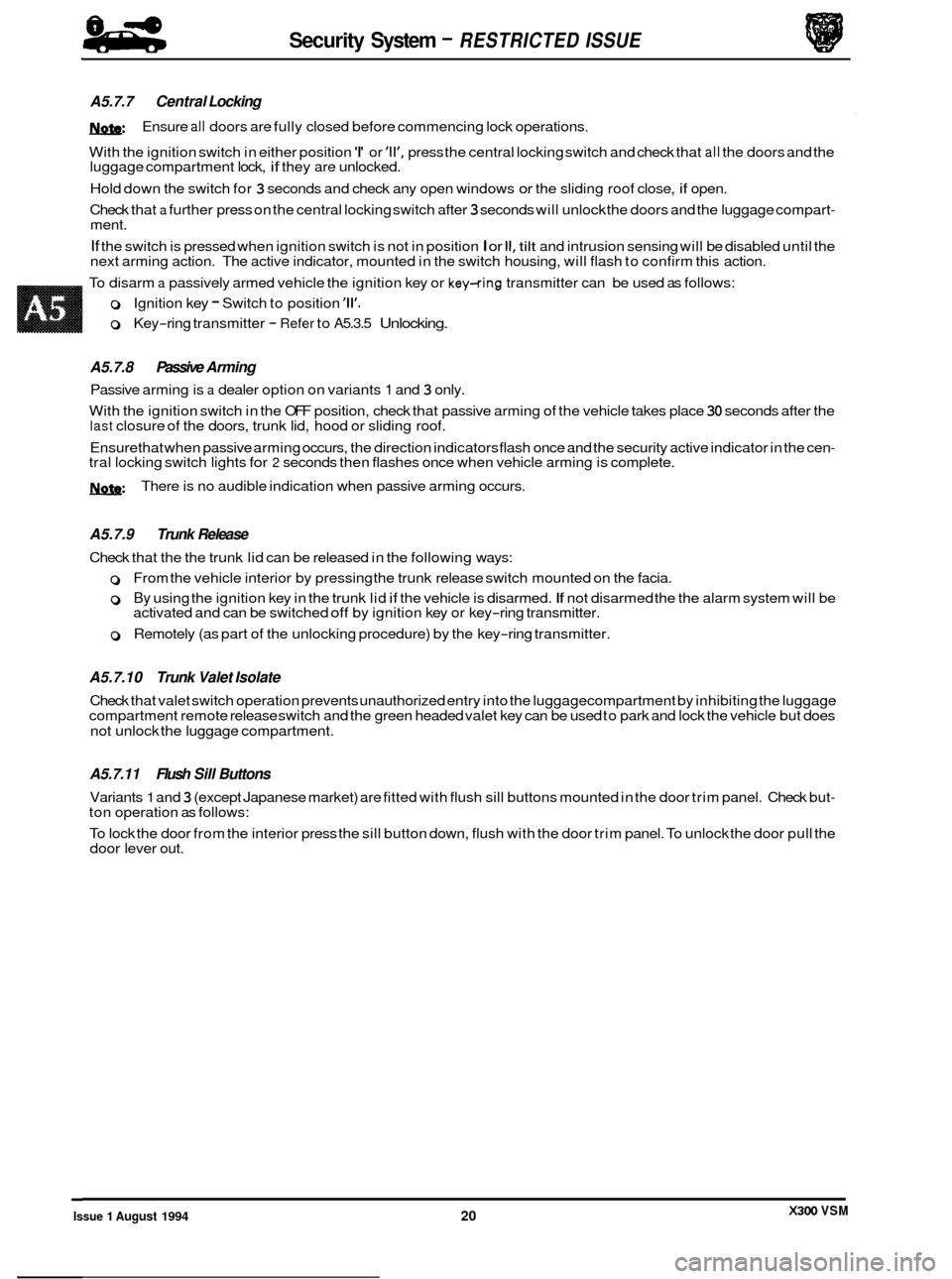
Security System - RESTRICTED ISSUE
A5.7.7 Central Locking
W
With the ignition switch in either position 'I' or 'll', press the central locking switch and check that all the doors and the
luggage compartment lock, if they are unlocked.
Hold down the switch for
3 seconds and check any open windows or the sliding roof close, if open.
Check that
a further press on the central locking switch after 3 seconds will unlock the doors and the luggage compart- ment.
If the switch is pressed when ignition switch is not in position I or II, tilt and intrusion sensing will be disabled until the
next arming action. The active indicator, mounted in the switch housing, will flash to confirm this action.
To disarm
a passively armed vehicle the ignition key or key-ring transmitter can be used as follows:
Ensure
all doors
are fully closed before commencing lock operations.
0 Ignition key - Switch to position '11'.
0 Key-ring transmitter - Refer to A5.3.5 Unlocking.
A5.7.8 Passive Arming
Passive arming is a dealer option on variants 1 and 3 only.
With the ignition switch in the OFF position, check that passive arming of the vehicle takes place
30 seconds after the last closure of the doors, trunk lid, hood or sliding roof.
Ensurethat when passive arming occurs, the direction indicators flash once and the security active indicator in the cen
- tral locking switch lights for 2 seconds then flashes once when vehicle arming is complete.
W There is no audible indication when passive arming occurs.
A5.7.9 Trunk Release
Check that the the trunk lid can be released in the following ways:
0 From the vehicle interior by pressing the trunk release switch mounted on the facia.
0 By using the ignition key in the trunk lid if the vehicle is disarmed. If not disarmed the the alarm system will be
activated and can be switched off by ignition key or key-ring transmitter.
0 Remotely (as part of the unlocking procedure) by the key-ring transmitter.
A5.7.10 Trunk Valet Isolate
Check that valet switch operation prevents unauthorized entry into the luggagecompartment by inhibiting the luggage
compartment remote release switch and the green headed valet key can be used to park and lock the vehicle but does
not unlock the luggage compartment.
A5.7.11 Flush Sill Buttons
Variants 1 and 3 (except Japanese market) are fitted with flush sill buttons mounted in the door trim panel. Check but- ton operation as follows:
To lock the door from the interior press the sill button down, flush with the door trim panel. To unlock the door pull the
door lever out.
X300 VSM Issue 1 August 1994 20
Page 503 of 521
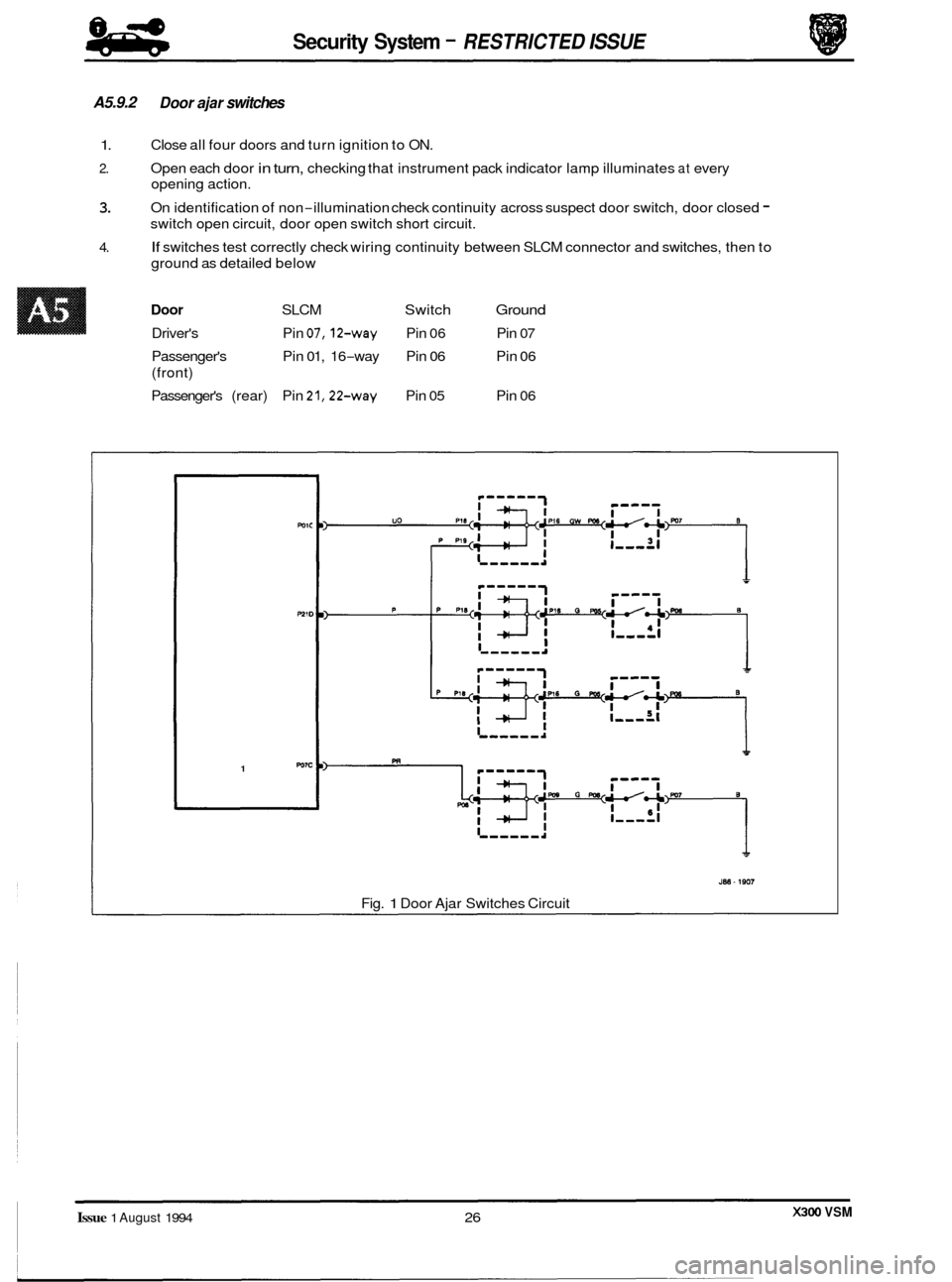
Security System - RESTRICTED ISSUE
A5.9.2
1.
2.
3.
4.
Door ajar switches
Close all four doors and turn ignition to ON.
Open each door in turn, checking that instrument pack indicator lamp illuminates at every
opening action.
On identification of non
-illumination check continuity across suspect door switch, door closed -
switch open circuit, door open switch short circuit.
If switches test correctly check wiring continuity between SLCM connector and switches, then to
ground as detailed below
Door SLCM Switch Ground
Driver's Pin 07,12-way Pin 06 Pin 07
Passenger's Pin 01, 16-way Pin
06 Pin 06
(front)
Passenger's (rear) Pin
21,22-way Pin 05 Pin 06
PolC
1 Po7C
J86 - 1907
Fig. 1 Door Ajar Switches Circuit
X300 VSM Issue 1 August 1994 26